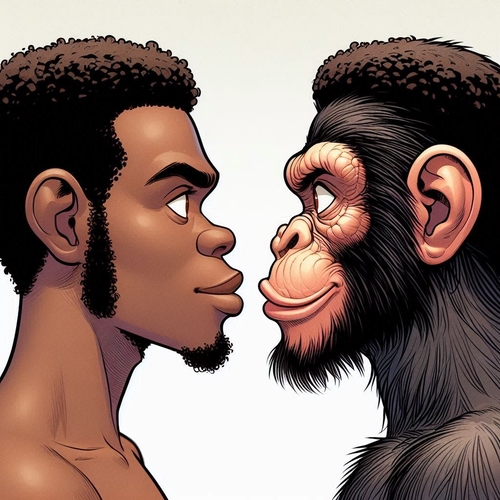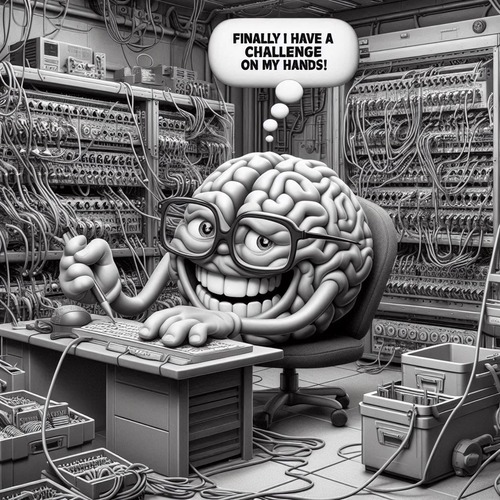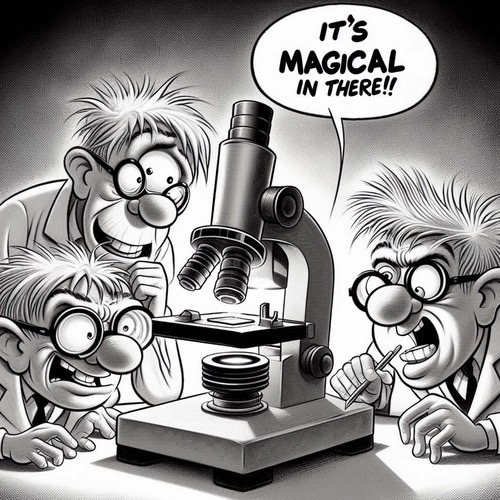Human and Chimp DNA: Are We Really 98% Identical?
The claim that we share 98% of our DNA with chimpanzees has become an often cited “fact” in popular science. From textbooks to documentaries, the statistic is presented as slam-dunk evidence for human evolution. But what if this widely accepted number tells only part of the story? When we examine the methodology behind these calculations and consider the full scope of genetic differences, a very different picture emerges—one that challenges evolutionary assumptions and points toward something far more remarkable.
THE MATHEMATICS PROBLEM: MORE THAN MEETS THE EYE
The 98% similarity claim isn’t based on comparing entire genomes. Instead, it comes from studies that cherry-picked the most similar regions between human and chimp DNA, then calculated percentages based on these pre-selected areas. It’s like comparing two novels by only looking at chapters where the authors happened to use similar vocabulary, then claiming the books are 98% identical.
Modern whole-genome sequencing reveals a more complex reality. When researchers include insertions, deletions, and structural variations that previous studies ignored, the similarity drops significantly. Conservative estimates now suggest the actual difference is closer to 10-15%—still substantial similarity, but far from the near-identity claimed by the 98% figure.
Consider the Y chromosome, which can be compared directly between males of both species. Here, the similarity plummets to just 70%. If humans and chimps descended from a common ancestor just 6-7 million years ago, as evolutionists claim, how could one chromosome diverge so dramatically while others remained nearly identical?
The numbers become even more intriguing when we examine so-called “junk DNA.” Once dismissed as evolutionary leftovers, these non-coding regions are proving to have crucial regulatory functions. The differences in these areas between humans and chimps are often much larger than in protein-coding genes, suggesting they play important roles in making us distinctly human.
FUNCTIONAL DIFFERENCES: SMALL CHANGES, MASSIVE IMPLICATIONS
Even a 2% difference in DNA represents roughly 60 million individual genetic variations—hardly a trivial amount. But raw numbers don’t tell the whole story. The location and nature of these differences create profound functional distinctions that make humans and chimps fundamentally different creatures.
- In brain-specific genes, the differences are particularly striking. The human brain uses energy at a rate nearly three times higher than a chimp’s brain, requires different developmental timing, and produces cognitive abilities that are qualitatively different from any other species. These aren’t just quantitative improvements—they represent entirely new categories of mental function, from abstract reasoning to symbolic language to moral consciousness.
- The famous FOXP2 gene, often called the “language gene,” Illustrates this principle perfectly. Humans and chimps differ by only two amino acids in this protein, yet these tiny changes appear to be crucial for human speech capabilities. If such small differences can have such massive functional consequences, what does this tell us about the significance of the tens of millions of other genetic variations between our species?
- Metabolic differences provide another compelling example. Humans and chimps process nutrients differently, have distinct immune system responses, and follow different developmental pathways. These coordinated changes across multiple biological systems suggest something more purposeful than random evolutionary tinkering.
THE EVOLUTIONARY DILEMMA: TIME AND PROBABILITY
Even accepting evolutionary timescales, the math doesn’t add up. If chimps and we split from a common ancestor 6-7 million years ago, the observed genetic differences would require mutation rates far higher than what we observe in real time. Population genetics calculations show most beneficial mutations would be lost through genetic drift in small populations, making coordinated changes across multiple systems highly improbable.
More challenging still is the coordination problem. Many human-specific traits require multiple genetic changes working together. Language, for instance, involves modifications in brain structure, vocal tract anatomy, breathing control, and neural processing—all of which must be coordinated to produce functional speech. The probability of random mutations producing such coordinated changes simultaneously across multiple systems stretches credibility.
The molecular clock, once considered evolution’s most reliable dating method, now presents its own problems. Different genes and proteins seem to “tick” at different rates, and the calculated divergence times often conflict with fossil evidence. These inconsistencies suggest that the molecular clock assumptions may be fundamentally flawed.
DESIGN EVIDENCE IN DNA PATTERNS
When we step back and examine the broader patterns in genetic data, evidence for purposeful design becomes compelling.
Common design elements: The similarities between human and chimp DNA don’t look random—they follow clear architectural principles that mirror what we see in human engineering.
Shared components: Just as a car and motorcycle share many components (wheels, engine, transmission) because they’re designed for similar functions, chimps and we share genetic modules because we’re both designed as mammals with similar physiological needs. The differences reflect the specific functions each creature was designed to perform.
Hierarchy in genetic information: The hierarchical organisation of genetic information particularly suggests design. Regulatory networks control gene expression in nested, modular patterns that mirror the structured approach human engineers use in complex systems. Random evolutionary processes would be expected to produce more chaotic, patched-together arrangements.
Perhaps most tellingly, the genetic differences between chimps and us aren’t randomly distributed. They cluster in functionally significant regions—brain development, immune function, sensory processing—exactly where we’d expect to find differences if we were specifically designed for unique roles and capabilities.
ALTERNATIVE INTERPRETATION: COMMON DESIGNER MODEL
Instead of seeing genetic similarities as evidence of common descent, we can interpret them as evidence of common design. A skilled engineer reuses successful designs, adapts proven solutions for new applications, and maintains consistency across related projects. The genetic toolkit shared by humans and chimps reflects optimal solutions for mammalian biology, not evolutionary accident.
This “orchard model” of life—where created kinds branch into varieties while maintaining distinct boundaries—better explains the patterns we observe. Humans and chimps share a designer’s toolkit but were crafted for entirely different purposes, like a violin and guitar sharing wood, strings, and acoustic principles while producing completely different musical experiences.
The concept of genetic “frontloading”—where a designer builds in the capacity for future adaptation—explains how species can vary within limits while maintaining their essential characteristics. We remain human regardless of racial or ethnic differences, just as dogs remain dogs despite breed variations.
THE EVIDENCE POINTS TO DESIGN
When we examine human and chimp DNA without evolutionary assumptions, the evidence points toward purposeful design rather than undirected evolution. The substantial functional differences, the coordinated nature of genetic changes, and the hierarchical organisation of genetic information all suggest an intelligent cause.
The 98% similarity claim, while containing a grain of truth, obscures more than it reveals. The real story lies in the functional significance of genetic differences and the elegant design principles underlying all life. Rather than seeing ourselves as sophisticated apes, we can recognise human beings as uniquely designed creatures, sharing common biological building blocks with other life forms while possessing distinctive capabilities that point to our special place in creation.
The question isn’t whether we share DNA features with chimps—we clearly do. The question is what this sharing means. Rather than evidence of common descent, it may be the signature of a common Designer who used optimal solutions to create the magnificent diversity of life we see around us.
HUMAN AND CHIMP DNA: RELATED FAQs
If we share a common designer with chimps, why do we have different numbers of chromosomes? We have 46 chromosomes (packages of DNA) while chimps have 48. This difference actually makes perfect sense from a design perspective. Think of chromosomes like filing cabinets for genetic information—a good designer might organize the same information using different filing systems for different purposes. The same genetic instructions can be packaged in different ways, just like the same books can be organized on different numbers of shelves.
- What about those viral DNA sequences that we share with chimps? Scientists have found pieces of DNA that look like ancient viruses in both human and chimp genomes, often in similar locations. However, many of these sequences are now proving to have important jobs in how our cells work. Rather than being leftover “junk” from evolution, they’re more like shared components that a designer placed in both species because both needed similar cellular functions. It’s like finding the same type of electrical wiring in different appliances—they’re there because they serve a purpose.
- Why would a perfect Designer create what appear to be genetic “mistakes” or mutations? The genetic problems we see today likely aren’t original design flaws but rather the result of thousands of years of decay since creation. Just like a beautiful building deteriorates over time without maintenance, our genetic code has accumulated damage over generations. The original designs were probably much more robust and perfect. Many things scientists once called “mistakes” are also turning out to have hidden functions we didn’t understand before.
Why do genetic studies show humans and chimps grouping together on “family trees”? When scientists compare DNA from different animals, they create tree-like diagrams showing similarities. Humans and chimps do group together, but this reflects similar design requirements rather than family relationships. It’s like how sports cars and racing motorcycles might group together in a comparison of vehicles—not because one evolved from the other, but because they’re both designed for speed and share similar engineering solutions.
- What about genetic evidence that suggests human populations were once very small? Our DNA does show signs that human populations went through “bottlenecks” where numbers dropped dramatically. But these fit perfectly with biblical history—the small number of people who survived Noah’s flood and later scattered from the Tower of Babel. The genetic diversity we see today could easily come from the variation already built into those founding families over thousands of years, not millions.
- How do creationists explain DNA “family trees” that seem to show evolution? These genetic family trees actually work better as design blueprints than evolutionary histories. When a designer creates related products, they naturally share more features with each other than with unrelated products. Animals with similar lifestyles or body plans will have similar genetic solutions because they face similar challenges. The same data that evolutionists see as a family tree, we can see as a design plan showing how the Creator organized life logically.
Why do we, like chimps, have DNA sequences that seem to serve no purpose? Very little DNA is actually “useless”—scientists keep discovering that DNA sections they once dismissed as “junk” actually have important jobs. What looks useless to us might serve purposes we haven’t figured out yet, like backup systems or instructions that only activate under certain conditions. Also, some sequences might have had functions that were lost over time due to genetic decay, but they were originally part of a perfect design.
HUMAN AND CHIMP DNA: OUR RELATED POSTS
Editor’s Pick

‘Out of Egypt I Called My Son’: Did Matthew Misuse Hosea 11:1?
When Matthew quotes Hosea 11:1 in his Gospel—“Out of Egypt I called my son”—he draws a connection that has puzzled [...]

Bible Allusions: How They Enrich Our Grasp of God’s Word
Ever experienced that moment when you're reading Scripture and suddenly recognise an echo of another passage? That spark of recognition [...]

Old Testament Theophanies: What Purposes Did They Serve?
Throughout the Old Testament, we encounter remarkable moments when God manifests Himself in visible, often tangible forms to His people. [...]

When Words Fail: How the Holy Spirit Helps Us in Our Prayers
Ever sat down to pray and found yourself at a complete loss for words? Or perhaps you’ve prayed diligently but [...]

Isaiah 64:6: How Are Our Righteous Deeds Like Filthy Rags?
“We have all become like one who is unclean, and all our righteous deeds are like a polluted garment.” — [...]

The Greatest Yet the Least: How Is John the Baptist Both?
In Matthew 11:11, Jesus makes a statement that has puzzled Bible readers: “Truly I tell you, among those born of [...]

The Pilgrim’s Progress: Journeying Through the Psalms of Ascent
The Psalms of Ascent (Psalms 120-134) are a remarkable collection of fifteen songs that have guided God's people for millennia. [...]

Not Home Yet: How Scripture’s Exile Theme Shapes Our Faith
When we read Scripture carefully, a striking pattern emerges: God’s people are almost always on the move, displaced, or living [...]

At Pentecost: God Fulfils Covenant and Reverses Babel
The scene is electrifying. Jerusalem, crowded with Jewish pilgrims from across the known world. A sound like rushing wind fills [...]

The Sun’s Age: Is It Really A Showstopper for A Young Earth?
When discussing creation and the age of the earth, sceptics often point to the sun as definitive evidence against the [...]





